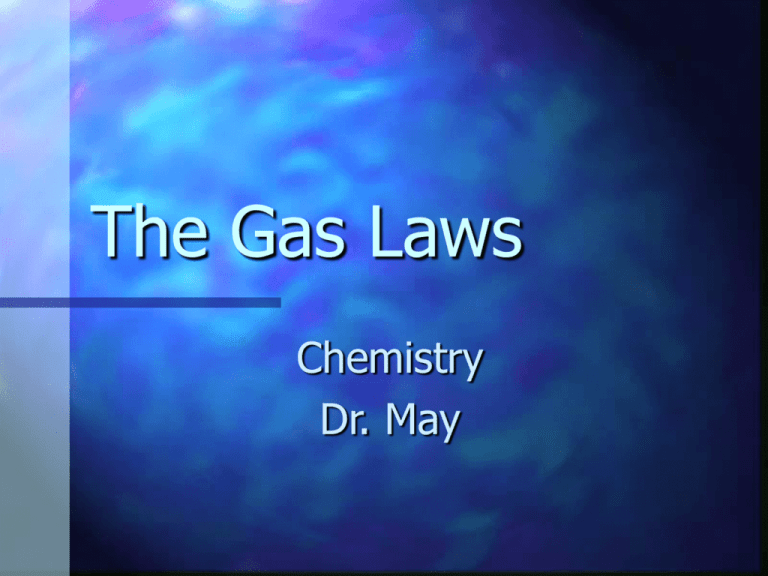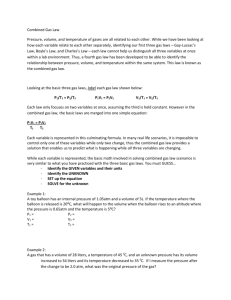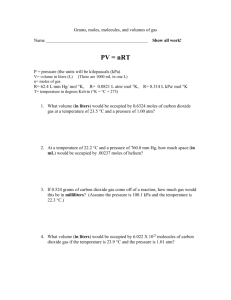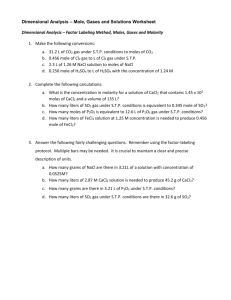The Gas Laws
advertisement

The Gas Laws Chemistry Dr. May Gaseous Matter Indefinite volume and no fixed shape Particles move independently of each other Particles have gained enough energy to overcome the attractive forces that held them together as solids and liquids Avogadro’s Number One mole of a gas contains Avogadro’s number of molecules Avogadro’s number is 6.02 x 1023 or 602,000,000,000,000,000,000,000 Diatomic Gas Elements Gas Hydrogen (H2) Nitrogen (N2) Oxygen (O2) Fluorine (F2) Chlorine (Cl2) Molar Mass 2 grams/mole 28 grams/mole 32 grams/mole 38 grams/mole 70 grams/mole Inert Gas Elements Gas Helium Neon Argon Krypton Xenon Radon Molar Mass 4 grams/mole 20 grams/mole 40 grams/mole 84 grams/mole 131 grams/mole 222 grams/mole Other Important Gases Gas Formula Molar Mass Carbon Dioxide Carbon Monoxide Sulfur Dioxide Methane Ethane Freon 14 CO2 CO SO2 CH4 CH3CH3 CF4 44 28 64 16 30 88 g/mole g/mole g/mole g/mole g/mole g/mole One Mole of Oxygen Gas (O2) Has a mass of 32 grams Occupies 22.4 liters at STP 273 Kelvins (0oC) One atmosphere (101.32 kPa)(760 mm) Contains 6.02 x 1023 molecules (Avogadro’s Number) Mole of Carbon Dioxide (CO2) Has a mass of 44 grams Occupies 22.4 liters at STP Contains 6.02 x 1023 molecules One Mole of Nitrogen Gas (N2) Has a mass of 28 grams Occupies 22.4 liters at STP Contains 6.02 x 1023 molecules Mole of Hydrogen Gas (H2) Mass 2.0 grams Volume at STP 22.4 liters Molecules 6.02 x 1023 Standard Conditions (STP) Molar Volume Standard Temperature Standard Pressure 22.4 liters/mole 0 oC 273 Kelvins 1 atmosphere 101.32 kilopascals 760 mm Hg Gas Law Unit Conversions liters milliliters milliliters liters o C Kelvins Kelvins o C mm atm atm mm atm kPa kPa atm Multiply by 1000 Divide by 1000 Add 273 Subtract 273 Divide by 760 Multiply by 760 Multiply by 101.32 Divide by 101.32 Charles’ Law At constant pressure, the volume of a gas is directly proportional to its temperature in Kelvins V1 T1 = V2 T2 As the temperature goes up , the volume goes up Boyle’s Law At constant temperature, the volume of a gas is inversely proportional to the pressure. P1V1 = P2V2 As the pressure goes up , the volume goes down Combined Gas Law P1V1 T1 = P2V2 T2 Standard Pressure (P) = 101.32 kPa, 1 atm, or 760 mm Hg Standard Temperature (T) is 273 K Volume (V) is in liters, ml or cm3 Charles’ Law Problem A balloon with a volume of 2 liters and a temperature of 25oC is heated to 38oC. What is the new volume? 1. Convert oC to Kelvins 25 + 273 = 298 K 38 + 273 = 311 K 2. Insert into formula Charles’ Law Solution V1 T1 V1 = 2 liters T1 = 298 K = V2 T2 V2 = Unknown T2 = 311 K 2 = V2 298 311 Charles’ Law Solution 2 298 = V2 311 298 V2 = (2) 311 V2 = 622 298 V2 = 2.09 liters Charles’ Law Problem Answer A balloon with a volume of 2 liters and a temperature of 25oC is heated to 38oC. What is the new volume? V2 = 2.09 liters Boyle’s Law Problem A balloon has a volume of 2.0 liters at 743 mm. The pressure is increased to 2.5 atmospheres (atm). What is the new volume? 1. Convert pressure to the same units 743 760 = .98 atm 2. Insert into formula Boyle’s Law Solution P1V1 = P2V2 P1 = 0.98 atm V1 = 2.0 liters P2 = 2.5 atm V2 = unknown 0.98 (2.0) = 2.5 V2 Boyle’s Law Solution P1V1 = P2V2 0.98 (2.0) = 2.5 V2 V2 = 0.98 (2.0) 2.5 V2 = 0.78 liters Boyle’s Law Problem Answer A balloon has a volume of 2.0 liters at 743 mm. The pressure is increased to 2.5 atmospheres (atm). What is the new volume? V2 = 0.78 liters Combined Gas Law Problem A balloon has a volume of 2.0 liters at a pressure of 98 kPa and a temperature of 25 oC. What is the volume under standard conditions? 1. 2. 3. 4. Convert 25 oC to Kelvins 25 + 273 = 298 K Standard pressure is 101.32 kPa Standard temperature is 273 K Insert into formula Combined Gas Law Solution P1V1 T1 P1 = 98 kPa V1 = 2.0 liters T1 = 298 K = P2V2 T2 P2 = 101.32 kPa V2 = unknown T2 = 273 K Combined Gas Law Solution P1V1 = T1 98 (2.0) 298 P2V2 T2 = 101.32 V2 273 (298) (101.32) V2 = (273) (98) (2.0) Combined Gas Law Solution P1V1 T1 = P2V2 T2 (298) (101.32) V2 = (273) (98) (2.0) V2 = 273 (98) (2.0) (298) (101.32) Combined Gas Law Solution P1V1 T1 V2 V2 = = = P2V2 T2 273 (98) (2.0) (298) (101.32) 53508 = 1.77 liters 30193 Combined Gas Law Problem Answer A balloon has a volume of 2.0 liters at a pressure of 98 kPa and a temperature of 25 oC. What is the volume under standard conditions? V2 = 1.77 liters Combined Gas Law – V2 P1V1 = T1 P2V2 T2 P1V1T2 = P2V2T1 P1V1T2 P2T1 = V2 The End This presentation was created for the benefit of our students by the Science Department at Howard High School of Technology Please send suggestions and comments to rmay@nccvt.k12.de.us The Ideal Gas Law Chemistry Dr. May Kinetic Molecular Theory Molecules of an ideal gas Are dimensionless points Are in constant, straight-line motion Have kinetic energy proportional to their absolute temperature Have elastic collisions Exert no attractive or repulsive forces on each other Ideal Gas Law PV = nRT P = pressure in kilopascals (kPa) or atmospheres (atm) V = volume in liters n = moles T = temperature in Kelvins R = universal gas constant Ideal Gas Law: PV = nRT Pressure (P) Volume (V) Moles (n) Temperature (T) The universal gas constant (R) Atm or kPa Always liters Moles Kelvins 0.0821 ( P in atm) or 8.3 (P in kPa) Universal Gas Constant R = 0.0821 if P = atmospheres R = 8.3 if P = kilopascals R = PV nT Deriving R for P in Atmospheres R = PV nT Assume n = 1 mole of gas Standard P = 1 atmosphere Standard V = molar volume = 22.4 liters Standard T = 273 Kelvins R Value When P Is In Atmospheres R = PV nT R = (1) (22.4) (1) 273 R = 0.0821 atm Liters mole Kelvins Deriving R For P In Kilopascals R = PV nT Assume n = 1 mole of gas Standard P = 101.32 kilopascals Standard V = molar volume = 22.4 liters Standard T = 273 Kelvins R Value When P Is In Kilopascals R = PV nT R = (101.32) (22.4) (1) 273 R = 8.3 kPa Liters mole Kelvins Ideal Gas Law - Pressure PV = nRT P = nRT V Solves for pressure when moles, temperature, and volume are known Ideal Gas Law - Volume PV = nRT V = nRT P Solves for volume when moles, temperature, and pressure are known Ideal Gas Law - Temperature PV = nRT T = PV nR Solves for temperature when moles, pressure, and volume are known Ideal Gas Law - Moles PV = nRT n = PV RT Solves for moles when pressure, temperature, and volume are known Ideal Gas Law Problem What is the mass of nitrogen in a 2.3 liter container at 1.2 atmospheres, and 25 oC ? V = 2.3 liters P = 1.2 atmospheres T = 25 oC = 298 Kelvins R = 0.0821 since P is in atms. Find moles (n), then grams Ideal Gas Law Solution (moles) PV = nRT 1.2 (2.3) = n (0.0821) (298) n = 1.2 ( 2.3) = 0.11 moles (0.0821) (298) Ideal Gas Law Solution (Grams) Grams = moles x molecular weight (MW) Moles = 0.11 Molecular Weight of N2 = 28 g/mole Grams = 0.11 x 28 = 3.1 grams Ideal Gas Law Answer What is the mass of nitrogen in a 2.3 liter container at 1.2 atmospheres, and 25 oC ? The answer is 0.11 moles and 3.1 grams The End This presentation was created for the benefit of our students by the Science Department at Howard High School of Technology Please send suggestions and comments to rmay@nccvt.k12.de.us






